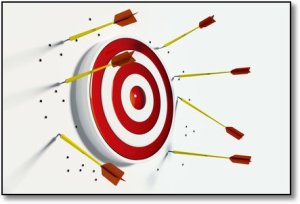A Bias for Failing?
By John Greco
Originally published on August 19, 2013
Re-posted with permission from johnponders blog
 Ready, fire, aim.
Ready, fire, aim.
Measure twice, cut once.
Uh oh. Wildly conflicting approaches.
What to do?
Measure twice cut once urges us to plan our work before we act. Plan, and then work the plan. Check our measurements before we cut. Don’t vary from the tried-and-true process. Make sure all i’s are dotted and all t’s crossed.
The implied consequence if we don’t? — wasted time, material, and effort when we have to cut again … and if we don’t have time to cut again? Poor quality.
This makes very good sense, and I’ll bet resonates with you.
So what then do we make of ready-fire-aim? What a stark contrast! Take action! then aim?
There’s a couple of ways I make sense of that instruction.
First, I imagine “aim” here is used more to suggest learning. Take action, and then learn from the result that the action produced. Self-correct. Get ready again, and fire again. And learn again. Adjust. Fire again.
Clearly, this approach actually builds in rework. How is that efficient?
In a very real sense, it’s not.
But, in some cases (and more than we think I would propose) it is moreeffective.
How can that be?
Seems to me that if the task at hand is to converge on a distinct future outcome that is known in advance, say, like building a cabinet, then the carpenter’s measure twice cut once is the right approach. If we know what we want; we know what we need to do, and we know what we have to work with, we can position our processes and resources, and
The measure twice cut once approach is slow, deliberate, methodical. Temporary inaction to produce eventual precision action. It places primary importance on the avoidance of error. And, therefore, on quality, and efficiency.
But what if things are changing all the time — objectives, policies and processes, technologies, people — and the “measuring twice” approach morphs into constant remeasuring? Error avoidance can become paralysis … we so fear missing the shot that we don’t ever take the shot …
Time for ready-fire-aim. And time for my second way of sense-making from those three out-of-order words.
Perhaps ready-fire-aim is not meant to be taken literally. Perhaps it is only to invoke a certain mindset.
A bias for action.
Take action, learn, adjust; take action, learn, adjust; take action and learn, and adjust, again …
It is an acceptance of the fact that we’re not going to get it right no matter how cautious, deliberate, and planful we are…
There can be no denying that there’s a whole lot of change happening in our lives these days, personally, professionally, in our communities, in our relationships …
Measure twice cut once might need to increasingly give way to ready-fire-aim. Because the complexity of all that change can become debilitating; immobilizing; stopping us in our tracks.
And I’m thinking that acting is what opens up the possibility of learning; because acting opens up the possibility of failing.
(Now I understand that inaction might be a great strategy given a certain set of conditions, but I’m thinking it is more the exception than the rule…)
Ready-fire-aim suggests we should have a bias for action.
Acting creates opportunities for learning.
From failure; because, clearly, acting in dynamic, changing environments is risky; we risk failing …
Our success will depend on our ability to learn from failing …
We can’t be afraid of that!
We must have a bias for action.

And trust and confidence that we will learn when we fail.
So, in an odd, yet fundamental way … a bias for failing?

